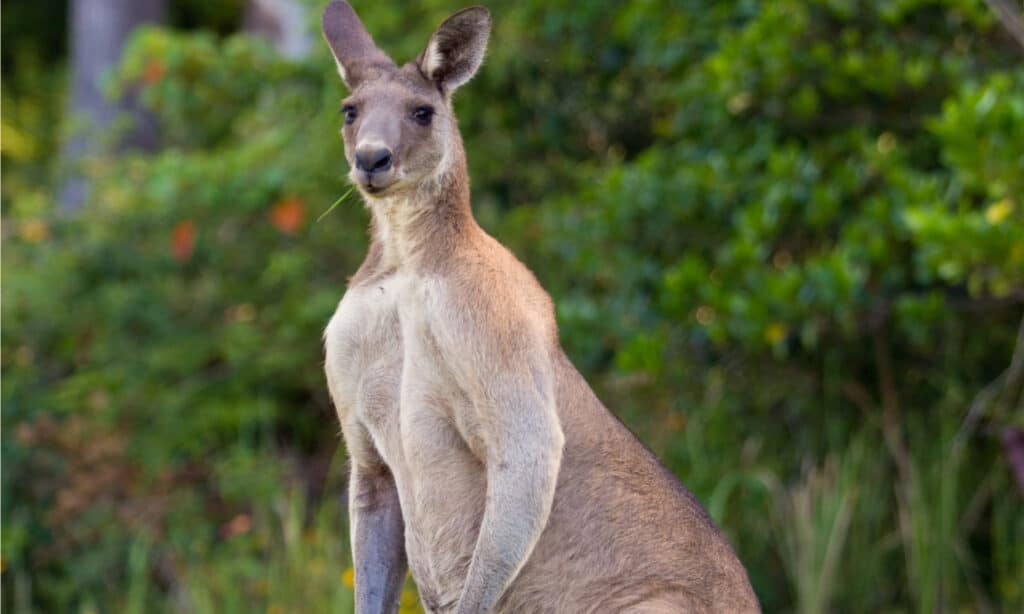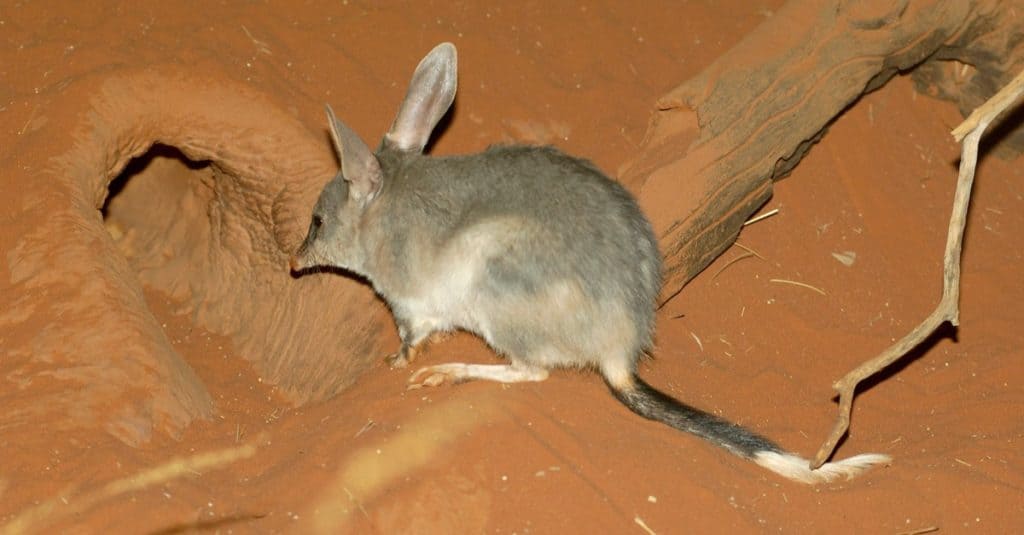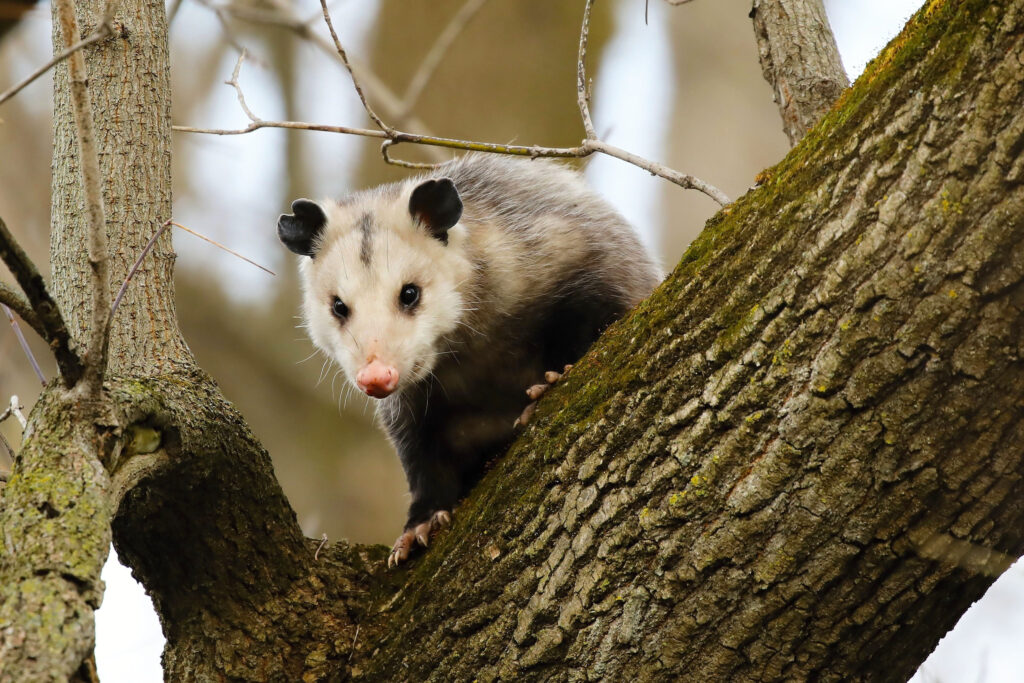Marsupials are a group of mammals that belong to the Metatheria (or Marsupialia) infraclass. One of the most common marsupials is the kangaroo, which gives birth prematurely to its young, and the baby continues to develop in its mother’s pouch. This is a common thread with marsupials, although not all marsupials have pouches. Most are found in Australia and New Guinea, but 70 species can be found in South America, with one native to North America. Of the 250 different species, 7 distinct types of marsupial animals have been categorized.
Do you think you know them all? Read on to find out all about the 7 distinct types of marsupials!
1) Kangaroos, Wallabies, Koala (Diprotodontia)

Rat kangaroos only get to be 15-20 inches tall, whereas the Eastern gray kangaroo can stand 6 ½ feet tall or more!
©kimonofish/Shutterstock.com
The Diprotodontia is the largest order of marsupials and has around 155 different species. The most well-known marsupials are kangaroos, wallabies and koalas. There are several families under the order Diprotodontia that include a few other species you may have heard of. While kangaroos and wallabies are in the same family, koalas are in separate families. Other animals in the kangaroo family are wallaroos and quokkas, a sub-family of wallabies. Years ago, the quokka was declared the happiest animal on Earth after a cute selfie went viral! You may be familiar with the chubby wombat that looks like a giant woodchuck. Wombats can get to be 3 feet long, making them the largest burrowing animal.
Diprotodontia also includes cute little gliders that can coast from tree to tree with large flaps of skin, like flying squirrels. They are sometimes called flying possums. There are several species that, include the tiny 6-inch pygmy glider to the larger greater glider that can reach 40 inches. Rat kangaroos, potoroos and bettongs all belong to the same family and look more mouse-like, but they do have similar long kangaroo-like feet. Rat kangaroos only get to be 15-20 inches tall, whereas the Eastern gray kangaroo can stand 6 ½ feet tall or more!
2) Tasmanian Devil, Quolls, Numbat (Dasyuromorphia)

The
Tasmanian devil
glows in the dark by absorbing ultraviolet light.
©james_stone76/Shutterstock.com
The next type of marsupial is sometimes called the carnivorous marsupial. Some marsupials, like koalas, for example, are herbivores and only eat plants. Koalas are known to have a very limited diet and only eat eucalyptus plants. But the carnivorous marsupials eat meat, and although that may seem more fierce, many of them are mouse-sized. The Tasmania devil is around 13-18 pounds and has a bit of an ornery reputation. Tasmanian devils look like small black bears with a more pointed snout. They do have a mouth full of sharp teeth, which they use to tear into prey and scavenged animals.
Quolls are smaller than Tasmanian devils, in the 3-15 pound range. The European settlers referred to these little marsupials as “native cats” in Australia and New Guinea, where they live. There are several kinds of quolls, but their fur is dark brown to black and has off-white spots. They have a long shrew-like snout and pink nose. The tiger quoll is the largest quoll and is sometimes called the spotted quoll with a spotted tail. They actively hunt at night and will eat birds, rats, frogs, lizards, small rabbits and possums.
Numbat Features
Numbats are another carnivorous marsupial, but they only eat termites instead of hunting small prey like mice and lizards. Similar to an anteater, they have a long sticky tongue that they use to suck up and consume termites, up to 20,000 termites a day. Numbats are small, with a body that is 7-12 inches, plus a skinny bushy tail. They have a unique striping of white and black on the back half of their body and a skinny pointed head. Unfortunately, there are only 1,000 of these left in the wild. Conservationists are working diligently to protect the numbat and several other marsupial species in Australia.
3) Bandicoots and Bilbies (Peramelemorphia)

Bilby, or rabbit-bandicoots, are a desert-dwelling marsupial.
©John Carnemolla/Shutterstock.com
“Bandicoots and Bilbies” sounds like a great name for an Australian brewery! But it is actually two of the marsupials found in the order Peramelemorphia. Bandicoots are a tad smaller than a gray squirrel coming in around 17-18 inches long, but they look more like a shrew with a long pointed snout and small pink nose. If you watched one burrowing for food, you may hear them make happy grunting noises, but if startled, they let out a yelp.
Bilbies are sometimes called rabbit bandicoots, and one look at them and you will understand why…the ears! They have cartoonishly large rabbit-like ears on a small bandicoot body. Their snouts are not quite as long as bandicoots, but their bodies are similar in size. They are burrowing animals that may have multiple burrows to provide adequate shelter. When newborn bilbies are born, they retreat to their mother’s pouch, where they will spend another 80 days developing before being ready to leave the pouch. One fun fact about bilbies is the female’s pouch is backward so that dirt and sand don’t end up filling up the pouch with the baby.
4) Marsupial Animals: Marsupial Moles (Notoryctemorphia)
Marsupial moles have a unique appearance with shimmery golden fur, but they lack ears and have functionally blind eyes. They are equipped with sharp front claws used for digging in the earth, but they seem to swim through the dirt vs burrowing. Due to their time in the dirt and sand, the females also have a backward-facing pouch to protect their young. They are quite a bit smaller than bandicoots, coming in at around 3 ½ – 7 inches. They are primarily found in Western Australia.
5) Monito del Monte (Microbiotheria)

The Monito del Monte is from Argentina and Chile and lives in the dense rainforests.
©Rob Jansen/Shutterstock.com
Although the majority of marsupials are from Australia and New Guinea, some marsupials are native to South America. The Monito del Monte is from Argentina and Chile and lives in the dense rainforests. These little ones are only 3-5 inches long and look a bit like mice, although they have some opossum-like characteristics. They are arboreal, living mostly in trees, and live off of insects and fruit, especially in summer. When it gets a bit chilly, they go into a state of torpor which is similar to hibernation. The newborn monito del monte gets to snuggle into a nice fur-lined pouch of the mother, where they remain for about five months.
6) Marsupial Animals: Opossums (Didelphimorphia)

Opossums have no control over when they play dead or for how long they do it: The comatose-like state is an involuntary reaction triggered by stress.
©Lisa Hagan/Shutterstock.com
Now we have a marsupial that can be found in North America! Kangaroos, koalas and bandicoots are not native to North America, but the Virginia Opossum is! Opossums look a bit like overgrown rats with a long, pointed snouts. They are about the size of a large cat and have grayish fur with a white head. Their prehensile tails are used to hold onto branches. They have a reputation for hanging upside down from tree branches. They can hang upside down but don’t really use this position to sleep, contrary to common belief.
When it comes to opossum babies, they can have a litter of 20 babies. However, 8-9 is more common. Once born and make it to their mama’s pouch, only about half survive. When the babies leave the pouch, they spend much of their time catching a ride on their mother’s back. After a few months, 4-5 months, they head off on their own. Somehow babies learn how to “play opossum,” which you have probably heard. Opossums start with a fierce display of their teeth, but if that doesn’t deter their predator, they will fall over and play dead! Seems to be an effective technique!
7) Shrew Opossums/Rat Opossums (Paucituberculata)

The marsupials in the Paucituberculata family are small shrew-like marsupials that live in the Andes Mountains of South America.
©Karel Bock/Shutterstock.com
The 7th distinct marsupial animal is the shrew or rat opossum. The marsupials in the Paucituberculata family are small shrew-like marsupials that live in the Andes Mountains of South America. One of the shrew opossums is the dusky caenolestid which can be found in northwest South America along the Andes in Columbia, Ecuador and Venezuela. They are only 4-5 inches long with a long tail, but unlike the Virginian opossum, their tail is not strong enough to support their weight of hanging upside down. Although they have a limited range, they are considered a species of “least concern” by the IUCN, thriving in the Andes as a species.
Marsupial Animals: Final Thoughts
You can clearly see the diversity within the marsupial animal group! From giant kangaroos to tiny shrew opossums and a little bit of everything in between, you can see how different the marsupials are. While most mammals are born ready to take on the world, the unique marsupial pouch or flap is just another way to “parent” their young. Another intriguing aspect of the animal world that keeps us all fascinated!
The photo featured at the top of this post is © iStock.com/Andrew Coleman
Thank you for reading! Have some feedback for us? Contact the AZ Animals editorial team.






